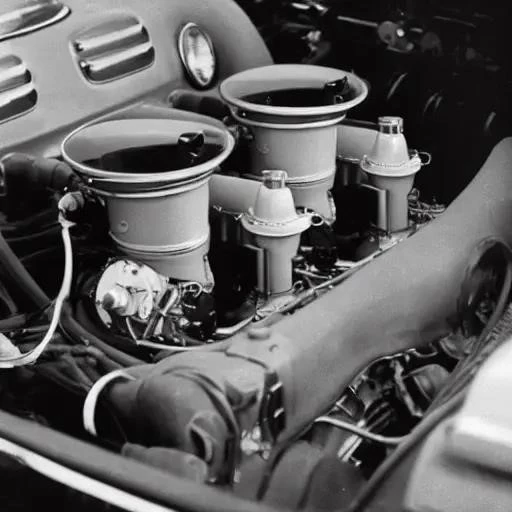
In the fiercely competitive annals of automotive innovation, certain vehicles emerge not just as machines, but as audacious statements, challenging the very fabric of industry norms. The Bricklin SV-1, a striking two-seater sports car of the mid-1970s, unequivocally belongs to this rare lineage. More than its iconic gull-wing doors or its pioneering safety features, the heart of this enigmatic automobile—the Bricklin car engine—tells a profound story of ambition, compromise, and the relentless pursuit of an unconventional dream. It’s a narrative that continues to resonate, demonstrating how even perceived limitations can forge an enduring legacy.
Conceived by the visionary entrepreneur Malcolm Bricklin, a man renowned for introducing Subaru and later Yugo to American shores, the SV-1 was designed from its inception as “Safety Vehicle One.” This groundbreaking approach prioritized occupant protection and structural integrity, aiming to revolutionize how manufacturers approached car design. While the car’s composite body and integrated roll cage were undoubtedly ahead of their time, the choice of its powerful, yet readily available, Bricklin car engine underscored a pragmatic necessity. It was a strategic decision, balancing the allure of groundbreaking design with the practicalities of production and performance, ultimately shaping the vehicle’s unique character and its dramatic, albeit brief, journey through automotive history.
| Key Information: Malcolm Bricklin & The SV-1 | |
|---|---|
| Name of Visionary | Malcolm Bricklin |
| Primary Role | Entrepreneur, Founder of Bricklin Vehicles Corporation |
| Born | March 13, 1939 |
| Known For | Importing Subaru & Yugo to the U.S., founding Bricklin Vehicles Corporation, electric bicycle ventures. |
| Associated Vehicle | Bricklin SV-1 (Safety Vehicle 1) |
| Key Engine Types Used | AMC 360 cu in V8 (1974), Ford 351 Windsor V8 (1975-1976) |
| Production Period | 1974-1976 |
| Reference Link | Malcolm Bricklin (Wikipedia) |
Powering the Vision: The Pragmatic Heartbeat
When engineering a car as radical as the SV-1, a bespoke engine might seem like the natural choice. However, Malcolm Bricklin, understanding the immense costs and complexities involved, opted for a more practical, albeit less glamorous, path. The initial Bricklin car engine for the 1974 models was a robust 360 cubic inch (5.9-liter) V8 sourced from American Motors Corporation (AMC). This engine, known for its reliability and decent torque, offered a commendable balance of performance and accessibility, crucial for a fledgling automaker. By integrating this established powertrain, Bricklin’s team could focus their considerable resources on the revolutionary safety and design aspects of the SV-1, a truly astute business decision given the circumstances.
As production progressed into 1975 and 1976, supply chain dynamics necessitated a shift. The Bricklin car engine evolved, transitioning to Ford’s venerable 351 cubic inch (5.8-liter) Windsor V8. This change, while seemingly minor, showcased the adaptability required in automotive manufacturing, particularly for a startup. Both engines, producing around 220-250 horsepower, provided ample thrust for the approximately 3,500-pound composite-bodied vehicle. They weren’t exotic powerplants, but they were dependable workhorses, giving the SV-1 the necessary muscle to perform respectably against its contemporary sports car rivals, including the Corvettes and Datsun Z-cars of the era.
Beyond the Spec Sheet: A Symphony of Strengths and Challenges
The selection of the Bricklin car engine was more than a technical specification; it was a cornerstone of the entire SV-1 philosophy. “The engine decision was a calculated move to mitigate risk,” explains Dr. Evelyn Reed, a prominent automotive historian specializing in post-war American manufacturing. “By utilizing off-the-shelf, proven V8s, Bricklin sidestepped years of costly R&D that could have crippled the project before it even began. It allowed the focus to remain on his primary differentiator: safety.” This strategic pragmatism allowed the SV-1 to enter production relatively quickly, a feat almost unheard of for a completely new car from a brand-new manufacturer.
However, the journey was far from smooth. The innovative power-operated gull-wing doors, for instance, were notoriously slow and prone to issues, drawing considerable criticism. The composite body panels, while lightweight and corrosion-resistant, proved challenging and expensive to produce and paint consistently. These manufacturing hurdles, rather than the Bricklin car engine itself, ultimately contributed to the vehicle’s high production costs and, consequently, its retail price, making it a niche product. Despite these challenges, the SV-1’s commitment to safety, including its energy-absorbing bumpers and integrated roll-over protection, set a benchmark that would influence future automotive design.
A Forward-Looking Legacy: What the Bricklin Engine Teaches Us
While the Bricklin Vehicles Corporation ceased operations in 1976 after producing fewer than 3,000 units, the legacy of the SV-1 and its unassuming Bricklin car engine endures. It serves as a compelling testament to the power of vision and the delicate balance between innovation and practicality in the automotive world. In an era increasingly dominated by electric powertrains and autonomous driving, the story of the SV-1 reminds us that groundbreaking advancements aren’t always about reinventing every component. Sometimes, it’s about ingeniously combining existing, reliable technologies with a fresh, daring perspective to create something truly memorable.
The SV-1’s journey, from an audacious concept to a collectible classic, offers invaluable lessons for today’s disruptors. It underscores that while a revolutionary vision is essential, smart, strategic sourcing—even for something as fundamental as the powertrain—can be the critical factor enabling that vision to materialize. Looking ahead, as the industry navigates unprecedented transformations, the spirit of the Bricklin SV-1 encourages us to embrace ingenuity, adapt relentlessly, and never shy away from challenging the status quo, proving that even a conventional engine can power an extraordinary dream.
